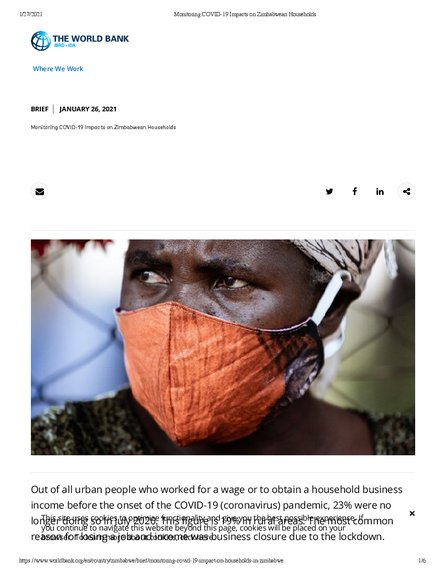
The survey, funded by Zimbabwe Reconstruction Fund, tracked the social, economic and welfare impact of the COVID-19 pandemic on households. It is also a high-frequency survey providing critical information on the consequences of the pandemic and informing national discussions on which population groups are affected most. The data will provide the evidence base for any mitigation programs that may be considered and track the implementation of those programs.
Specifically, the survey was designed to:
- Understand household knowledge, perspectives and behavioral responses to COVID-19
- Monitor household access to food, medicine, water, education, and government assistance and assess the economic impacts on wage workers, family business, farming and non-labor income.
- Track COVID-19 impact on food security, welfare, confidence
- Provide evidence to support programs and improving targeting and management
The sample is representative for the urban and rural population and covers all 10 provinces in the country. Detailed information on household characteristics and baseline data on consumption and income-earning patterns as well as social assistance access is already available for most of these households as they were interviewed for the Poverty Income, Consumption and Expenditure Survey (PICES) of 2017 and the Mini-PICES 2019 (funded by the Zimbabwe Reconstruction Fund). This makes it easier to assess changes over time.
Top-line findings of the survey include:
- Households in Zimbabwe are well aware of COVID-19. Nearly everyone (99%) has heard about COVID-19 and knows the symptoms and preventive measures.
- Frequent hand washing is commonly adopted but is constrained by water shortages which are reported by 21% of urban households compared to 9% of rural respondents, and a shortage of soap which affects a quarter of rural households compared to 14 % of urban households.
- There has been a considerable fall in household income since the start of the pandemic. Ninety percent of households which operated a non-farm business (about 33% in urban areas) reported a drop in revenue. Forty-four percent of wage workers (which form about 60% of urban workers) reported a reduction or disappearance of wages. This adds up to more than half of urban workers who have witnessed a drop in income. The problem affects urban areas in particular as the proportion of people working for a wage or operating a non-farm business is much higher than in rural areas.
- The pandemic has had a considerable impact on employment. Roughly 64% of respondents reported having a job before the imposition of mobility restrictions; this was reduced to 51% in July 2020. Urban areas were most affected by job loss as 18 percent of respondents in urban areas were working before Covid-19 but no longer were in July 2020 (Figure 1). The most commonly cited reason for no longer working was business closure due to Covid-19 restrictions.
Fewer than half the children who were in school before the pandemic were engaged in any distance learning following school closure. In rural areas, only one quarter of children were engaged in school while in urban areas, this proportion was 70%. In rural areas, the most common means for distance learning is through parental assignments, whereas in urban areas it is through mobile phones.